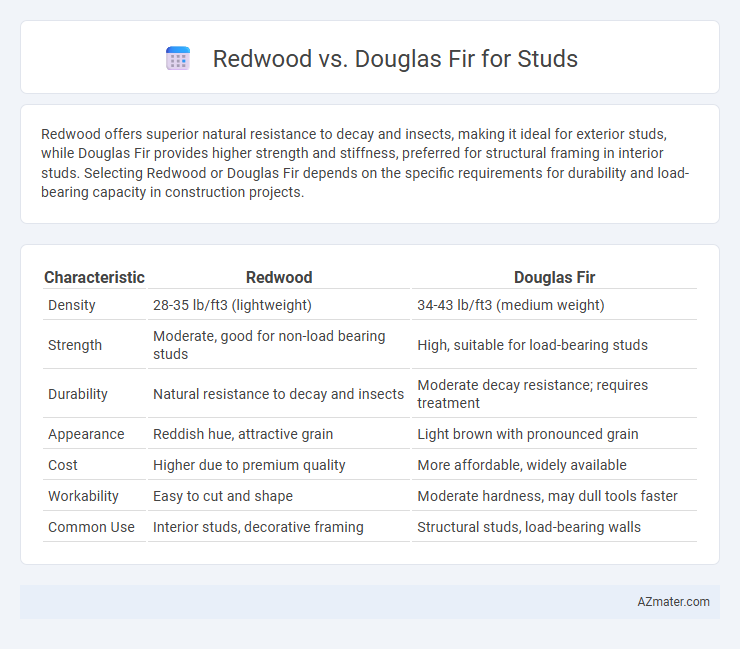Redwood offers superior natural resistance to decay and insects, making it ideal for exterior studs, while Douglas Fir provides higher strength and stiffness, preferred for structural framing in interior studs. Selecting Redwood or Douglas Fir depends on the specific requirements for durability and load-bearing capacity in construction projects.
Table of Comparison
| Characteristic | Redwood | Douglas Fir |
|---|---|---|
| Density | 28-35 lb/ft3 (lightweight) | 34-43 lb/ft3 (medium weight) |
| Strength | Moderate, good for non-load bearing studs | High, suitable for load-bearing studs |
| Durability | Natural resistance to decay and insects | Moderate decay resistance; requires treatment |
| Appearance | Reddish hue, attractive grain | Light brown with pronounced grain |
| Cost | Higher due to premium quality | More affordable, widely available |
| Workability | Easy to cut and shape | Moderate hardness, may dull tools faster |
| Common Use | Interior studs, decorative framing | Structural studs, load-bearing walls |
Redwood vs Douglas Fir: Overview
Redwood and Douglas Fir are popular choices for studs in construction due to their strength and durability. Redwood offers natural resistance to decay and insects, making it ideal for moisture-prone environments, while Douglas Fir boasts superior structural strength and stiffness, suitable for load-bearing applications. Both woods have distinct grain patterns and aesthetic qualities, with Redwood typically favored for its rich, reddish hue and Douglas Fir for its uniform texture and light color.
Strength and Durability Comparison
Redwood offers moderate strength with a Janka hardness of 420, making it less dense than Douglas Fir, which boasts a Janka hardness of 660 and superior structural strength, ideal for heavy-load framing. Douglas Fir's high strength-to-weight ratio and excellent durability under stress make it the preferred choice for studs in construction where stability is crucial. Redwood excels in natural decay resistance due to its tannins, but Douglas Fir requires treatment to match durability, emphasizing Douglas Fir's dominance in strength-critical stud applications.
Resistance to Decay and Insects
Redwood exhibits superior natural resistance to decay and insects due to its high concentration of tannins and natural oils, making it an ideal choice for studs in environments prone to moisture or pest exposure. Douglas Fir, while structurally strong, is less resistant and often requires chemical treatment to enhance its durability against rot and insect damage. Builders prioritizing longevity and minimal maintenance frequently select Redwood for studs in outdoor or high-humidity applications.
Weight and Workability
Redwood studs have a lighter weight, typically around 28 pounds per cubic foot, making them easier to handle and transport compared to Douglas Fir, which averages about 34 pounds per cubic foot. The softer texture of Redwood enhances its workability, allowing for smoother cutting, shaping, and nailing, while Douglas Fir's denser, harder grain requires more effort but provides greater strength. Both woods are favored in construction, but choosing Redwood offers the advantage of reduced labor strain without compromising moderate durability.
Price and Availability
Douglas Fir studs are generally more affordable and widely available across North America, making them a cost-effective choice for construction projects. Redwood studs tend to be pricier due to their premium quality and natural resistance to decay, with limited availability mostly in specialized lumber suppliers. Builders often prefer Douglas Fir for budget-sensitive projects, while Redwood is selected for applications requiring enhanced durability and aesthetic appeal despite its higher cost.
Environmental Impact and Sustainability
Redwood and Douglas Fir studs differ significantly in environmental impact and sustainability; Redwood is prized for its natural resistance to decay, reducing the need for chemical treatments and extending the lifespan of structures. Douglas Fir, often sourced from rapidly managed forests, promotes sustainable forestry practices through certification programs such as FSC, ensuring responsible harvesting and reforestation efforts. Choosing either wood as a stud option can impact carbon sequestration and forest ecosystem health, with local sourcing further minimizing transportation emissions.
Appearance and Aesthetics
Redwood features a rich reddish-brown hue with fine, straight grain patterns that enhance the visual appeal of studs in both modern and rustic interiors. Douglas Fir showcases a lighter, creamy to reddish-brown color with a pronounced, coarse grain that provides a more robust and natural look. While Redwood is prized for its warm, uniform appearance, Douglas Fir's distinct grain texture offers a bold aesthetic ideal for structural and decorative applications.
Common Applications for Each Wood
Redwood is commonly used for interior framing and trim due to its natural resistance to decay and attractive grain, making it ideal for visible structural elements. Douglas Fir is favored for structural studs in walls and heavy construction because of its superior strength, stiffness, and availability in larger dimensions. Both woods are popular in residential and commercial building but Douglas Fir typically excels in load-bearing applications while Redwood is preferred in environments where moisture resistance is critical.
Building Code Considerations
Redwood and Douglas Fir are common choices for studs, but building codes often favor Douglas Fir due to its higher strength-to-weight ratio and better structural performance in load-bearing applications. Douglas Fir studs typically meet stringent International Building Code (IBC) requirements for shear and bending strength, making them suitable for high-stress environments and multistory construction. Redwood, while resistant to decay, generally has lower density and strength values, which may require larger dimensions or additional reinforcements to comply with building code standards.
Which Wood is Best for Your Project?
Douglas Fir is often preferred for studs due to its superior strength, stiffness, and resistance to warping, making it ideal for load-bearing walls. Redwood offers excellent natural resistance to decay and insects, but it is softer and more expensive, generally suited for projects where durability against moisture and rot is critical. For most construction applications requiring structural integrity and cost-effectiveness, Douglas Fir is the best choice for studs.

Infographic: Redwood vs Douglas Fir for Stud
 azmater.com
azmater.com